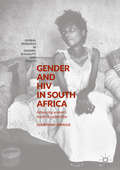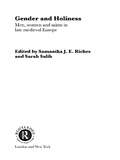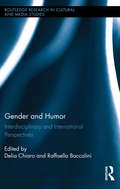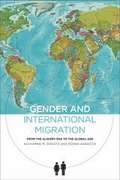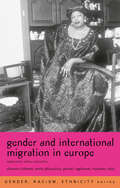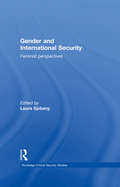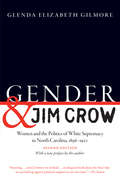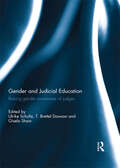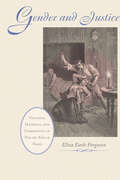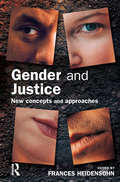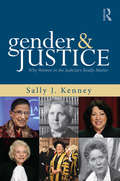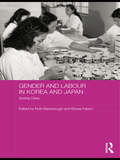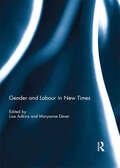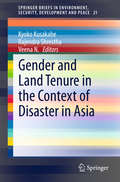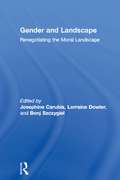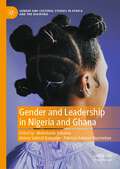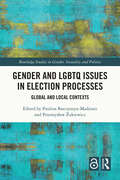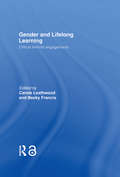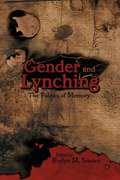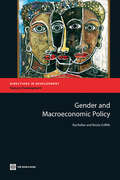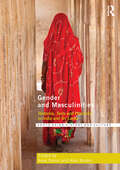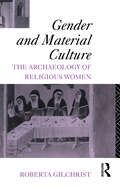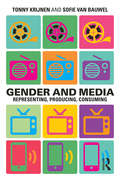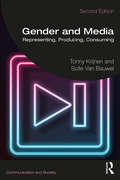- Table View
- List View
Gender and HIV in South Africa: Advancing Women's Health And Capabilities (Global Research In Gender, Sexuality And Health Ser.)
by Courtenay SpragueThis book addresses the ongoing problem of HIV in black South African women as a health inequity. Importantly, it argues that this urgent problem of justice is changeable. Sprague uses the capabilities approach to bring a theory of health justice, together with multiple sources of evidence, to investigate the complex problem of HIV and accompanying poor health outcomes in black South African women. Motivated by a concern for application of knowledge, this work discusses how to better conceptualise what health justice demands of state and society, and how to mobilise available evidence on health inequities in ways that compel greater state action to address problems of gender and health. HIV in women, and possible responses, are investigated on four distinct levels: conceptual, social structure, health systems, and law. The analysis demonstrates that this problem is indeed modifiable with long-term interventions and an enhanced state response targeted at multiple levels. This book will be of interest to academics and students in the social health sciences, gender and development studies, and global health, as well as HIV/health activists, government officials, policy makers, HIV clinicians and health providers interested in HIV.
Gender and Holiness: Men, Women and Saints in Late Medieval Europe (Routledge Studies in Medieval Religion and Culture #No.1)
by Samantha J. E. Riches Sarah SalihThis collection brings together two flourishing areas of medieval scholarship: gender and religion. It examines gender-specific religious practices and contends that the pursuit of holiness can destabilise binary gender itself. Though saints may be classified as masculine or feminine, holiness may also cut across gender divisions and demand a break from normally gendered behaviour. This work of interdisciplinary cultural history includes contributions from historians, art historians and literary critics and will be of interest not only to medievalists, but also to students of religion and gender in any period.
Gender and Humor: Interdisciplinary and International Perspectives (Routledge Research in Cultural and Media Studies)
by Delia Chiaro Raffaella BaccoliniIn the mid-seventies, both gender studies and humor studies emerged as new disciplines, with scholars from various fields undertaking research in these areas. The first publications that emerged in the field of gender studies came out of disciplines such as philosophy, history, and literature, while early works in the area of humor studies initially concentrated on language, linguistics, and psychology. Since then, both fields have flourished, but largely independently. This book draws together and focuses the work of scholars from diverse disciplines on intersections of gender and humor, giving voice to approaches in disciplines such as film, television, literature, linguistics, translation studies, and popular culture.
Gender and International Migration
by Donna Gabaccia Katharine M. DonatoIn 2006, the United Nations reported on the “feminization” of migration, noting that the number of female migrants had doubled over the last five decades. Likewise, global awareness of issues like human trafficking and the exploitation of immigrant domestic workers has increased attention to the gender makeup of migrants. But are women really more likely to migrate today than they were in earlier times? In Gender and International Migration, sociologist and demographer Katharine Donato and historian Donna Gabaccia evaluate the historical evidence to show that women have been a significant part of migration flows for centuries. The first scholarly analysis of gender and migration over the centuries, Gender and International Migration demonstrates that variation in the gender composition of migration reflect not only the movements of women relative to men, but larger shifts in immigration policies and gender relations in the changing global economy. While most research has focused on women migrants after 1960, Donato and Gabaccia begin their analysis with the fifteenth century, when European colonization and the transatlantic slave trade led to large-scale forced migration, including the transport of prisoners and indentured servants to the Americas and Australia from Africa and Europe. Contrary to the popular conception that most of these migrants were male, the authors show that a significant portion were women. The gender composition of migrants was driven by regional labor markets and local beliefs of the sending countries. For example, while coastal ports of western Africa traded mostly male slaves to Europeans, most slaves exiting east Africa for the Middle East were women due to this region’s demand for female reproductive labor. Donato and Gabaccia show how the changing immigration policies of receiving countries affect the gender composition of global migration. Nineteenth-century immigration restrictions based on race, such as the Chinese Exclusion Act in the United States, limited male labor migration. But as these policies were replaced by regulated migration based on categories such as employment and marriage, the balance of men and women became more equal – both in large immigrant-receiving nations such as the United States, Canada, and Israel, and in nations with small immigrant populations such as South Africa, the Philippines, and Argentina. The gender composition of today’s migrants reflects a much stronger demand for female labor than in the past. The authors conclude that gender imbalance in migration is most likely to occur when coercive systems of labor recruitment exist, whether in the slave trade of the early modern era or in recent guest-worker programs. Using methods and insights from history, gender studies, demography, and other social sciences, Gender and International Migration shows that feminization is better characterized as a gradual and ongoing shift toward gender balance in migrant populations worldwide. This groundbreaking demographic and historical analysis provides an important foundation for future migration research.
Gender and International Migration in Europe: Employment, Welfare and Politics (Gender, Racism, Ethnicity Ser.)
by Eleonore Kofman Parvati Raghuram Rosemary Sales Annie PhizackleaGender and International Migration in Europe is a unique work which introduces a gender dimension into theories of contemporary migrations. As the European Union seeks to extend equal opportunities, increasingly restrictionist immigration policies and the persistence of racism, deny autonomy and choice to migrant women. This work demonstrates how processes of globalisation and change in state policies on employment and welfare have maintained a demand for diverse forms of gendered immigration.The authors examine state and European Union policies of immigration control, family reunion, refugees and the management of immigrant and ethnic minority communities. Most importantly this work considers the opportunities created for political activity by migrant women and the extent to which they are able to influence and participate in mainstream policy-making.This volume will be essential reading for anyone involved in or interested in modern European immigration policy.
Gender and International Security: Feminist Perspectives (Routledge Critical Security Studies #17)
by Laura SjobergThis book defines the relationship between gender and international security, analyzing and critiquing international security theory and practice from a gendered perspective. Gender issues have an important place in the international security landscape, but have been neglected both in the theory and practice of international security. The passage and implementation of UN Security Council Resolution 1325 (on Security Council operations), the integration of gender concerns into peacekeeping, the management of refugees, post-conflict disarmament and reintegration and protection for non-combatants in times of war shows the increasing importance of gender sensitivity for actors on all fronts in global security. This book aims to improve the quality and quantity of conversations between feminist security studies and security studies more generally, in order to demonstrate the importance of gender analysis to the study of international security, and to expand the feminist research program in Security Studies. The chapters included in this book not only challenge the assumed irrelevance of gender, they argue that gender is not a subsection of security studies to be compartmentalized or briefly considered as a side issue. Rather, the contributors argue that gender is conceptually, empirically, and normatively essential to studying international security. They do so by critiquing and reconstructing key concepts of and theories in international security, by looking for the increasingly complex roles women play as security actors, and by looking at various contemporary security issues through gendered lenses. Together, these chapters make the case that accurate, rigorous, and ethical scholarship of international security cannot be produced without taking account of women's presence in or the gendering of world politics. This book will be of interest to all students of critical security studies, gender studies and International Relations in general. Laura Sjoberg is Assistant Professor of Political Science at the University of Florida. She has a Phd in International Relations and Gender Studies from the University of Southern California and is the author of Gender, Justice, and the Wars in Iraq (2006) and, with Caron Gentry, Mothers, Monsters, Whores: Women's Violence in Global Politics (2007)
Gender and Jim Crow
by Glenda Elizabeth GilmoreGlenda Gilmore recovers the rich nuances of southern political history by placing black women at its center. She explores the pivotal and interconnected roles played by gender and race in North Carolina politics from the period immediately preceding the disfranchisement of black men in 1900 to the time black and white women gained the vote in 1920. Gender and Jim Crow argues that the ideology of white supremacy embodied in the Jim Crow laws of the turn of the century profoundly reordered society and that within this environment, black women crafted an enduring tradition of political activism. According to Gilmore, a generation of educated African American women emerged in the 1890s to become, in effect, diplomats to the white community after the disfranchisement of their husbands, brothers, and fathers. Using the lives of African American women to tell the larger story, Gilmore chronicles black women's political strategies, their feminism, and their efforts to forge political ties with white women. Her analysis highlights the active role played by women of both races in the political process and in the emergence of southern progressivism. In addition, Gilmore illuminates the manipulation of concepts of gender by white supremacists and shows how this rhetoric changed once women, black and white, gained the vote.
Gender and Jim Crow, Second Edition: Women and the Politics of White Supremacy in North Carolina, 1896-1920 (Gender and American Culture)
by Glenda Elizabeth GilmoreThis classic work helps recover the central role of black women in the political history of the Jim Crow era. Glenda Elizabeth Gilmore explores the pivotal and interconnected roles played by gender and race in North Carolina politics from the period immediately preceding the disfranchisement of black men in 1900 to the time black and white women gained the vote in 1920. Gilmore argues that while the ideology of white supremacy reordered Jim Crow society, a generation of educated black women nevertheless crafted an enduring tradition of political activism. In effect, these women served as diplomats to the white community after the disfranchisement of their husbands, brothers, and fathers. Gilmore also reveals how black women's feminism created opportunities to forge political ties with white women, helping to create a foundation for the emergence of southern progressivism. In addition, Gender and Jim Crow illuminates the manipulation of concepts of gender by white supremacists and shows how this rhetoric changed once women, black and white, gained the vote.
Gender and Judicial Education: Raising Gender Awareness of Judges
by Ulrike Schultz, T. Brettel Dawson and Gisela ShawJudicial Education has greatly expanded in common law countries in the past 25 years. More recently it has become a core component in judicial reform programs in developing countries with gender attentiveness as an element required by donor agencies. In civil law jurisdictions judges´ schools have long played a role in the formation of the career judiciary with a focus on entry to the judicial profession, in some countries judges get an intensive in-service education at judicial academies. Gender questions, however, tend to be neglected in the curricula.These judicial education activities have generated a significant body of material and experience which it is timely to review and disseminate. Questions such as the following require answers. What is the current state of affairs? How is judicial education implemented in developed and developing countries all around the world? Who are the educators? Who is being educated? How is judicial education on gender regarded by judges? How effective are these programs?The chapters in this book deal with these questions. They provide a multiplicity of perspectives. Six countries are represented, of these four are civil law countries (Germany, Argentina, Japan, Bosnia and Herzegovina) and two are common law countries (Canada; Uganda). This book was previously published as a special issue of International Journal of the Legal Profession.
Gender and Justice: Violence, Intimacy, and Community in Fin-de-Siècle Paris (The Johns Hopkins University Studies in Historical and Political Science #128)
by Eliza Earle FergusonHistorian Eliza Earle Ferguson’s meticulously researched study of domestic violence among the working class in France uncovers the intimate details of daily life and the complex workings of court proceedings in fin-de-siècle Paris. With detective-like methods, Ferguson pores through hundreds of court records to understand why so many perpetrators of violent crime were fully acquitted. She finds that court verdicts depended on community standards for violence between couples. Her search uncovers voluminous testimony from witnesses, defendants, and victims documenting the conflicts and connections among men and women who struggled to balance love, desire, and economic need in their relationships.Ferguson's detailed analysis of these cases enables her to reconstruct the social, cultural, and legal conditions in which they took place. Her ethnographic approach offers unprecedented insight into the daily lives of nineteenth-century Parisians, revealing how they chose their partners, what they fought about, and what drove them to violence. In their battles over money and sex, couples were in effect testing, stretching, and enforcing gender roles.Gender and Justice will interest social and legal historians for its explanation of how the working class of fin-de-siècle Paris went about their lives and navigated the judicial system. Gender studies scholars will find Ferguson’s analysis of the construction of gender particularly trenchant.
Gender and Justice
by Frances HeidensohnQuestions about gender, justice and crime are constantly in the public arena, whether they focus on young women getting drunk or taking drugs, or the rising numbers of women going to prison or committing violent crimes, or reports of macho behaviour on the part of men in the military, law enforcement or professional sport. This book provides a key text for students seeking to understand feminist and gendered perspectives on criminology and criminal justice, bringing together the most innovative research and work which has taken the study of the relationship between gender and justice into the twenty-first century. The book addresses many of the issues of concern to the established feminist agenda (such as the gender gap, equity in the criminal justice system, penal regimes and their impact on women), but also shows the ways in which these themes have been extended, reinterpreted and answered in new and distinctive ways. Organised into sections on gender and offending behaviour, gender and the criminal justice system, and new concepts and approaches, Gender and Justice: new concepts and approaches will be essential reading for students taking courses in criminology and criminal justice, and anybody else wishing to understand the complex and changing relationship between gender and justice.
Gender and Justice: Why Women in the Judiciary Really Matter (Perspectives on Gender)
by Sally J. KenneyIntended for use in courses on law and society, as well as courses in women’s and gender studies, women and politics, and women and the law, this book explores different questions in different North American and European geographical jurisdictions and courts, demonstrating the value of a gender analysis of courts, judges, law, institutions, organizations, and, ultimately, politics. Gender and Justice argues empirically for both more women and more feminists on the bench, while demonstrating that achieving these two aims are independent projects.
Gender and Labour in Korea and Japan: Sexing Class (ASAA Women in Asia Series)
by Ruth Barraclough Elyssa FaisonBringing together for the first time sexual and industrial labour as the means to understand gender, work and class in modern Japan and Korea, this book shows that a key feature of the industrialisation of these countries was the associated development of a modern sex labour industry. Tying industrial and sexual labour together, the book opens up a range of key questions: In what economy do we place the labour of the former "comfort women"? Why have sex workers not been part of the labour movements of Korea and Japan? Why is it difficult to be "working-class" and "feminine"? What sort of labour hierarchies operate in hostess clubs? How do financial crises translate into gender crises? This book explores how sexuality is inscribed in working-class identities and traces the ways in which sexual and labour relations have shaped the cultures of contemporary Japan and Korea. It addresses important historical episodes such as the Japanese colonial industrialisation of Korea, wartime labour mobilisation, women engaged in forced sex work for the Japanese army throughout the Asian continent, and issues of ethnicity and sex in the contemporary workplace. The case studies provide specific examples of the way gender and work have operated across a variety of contexts, including Korean shipyard unions, Japanese hostess clubs, and the autobiographical literature of Korean factory girls. Overall, this book provides a compelling account of the entanglement of sexual and industrial labour throughout the twentieth century, and shows clearly how ideas about gender have contributed in fundamental ways to conceptions of class and worker identities.
Gender and Labour in New Times
by Lisa Adkins and Maryanne DeverThis book is concerned with the gender order of post-Fordism, and especially the labour demanded from many women by post-Fordist capitalism. It maps and traces these demands as well their entanglement in complex processes of value creation. In so doing the contributors elaborate how processes of financialization; calls for work-readiness; new modes of economic calculation; processes of economization, and emergent regulatory strategies are reconfiguring labour and life in post-Fordism and summoning new forms of ‘women’s work’. Contributors also map how these same processes are repositioning feminism, especially feminism as a mode of critique. Feminism here stands not in an external relation to the objects and matters it seeks to critique but as implicated in those very objects. In mapping this terrain Gender and Labour in New Times opens out new feminist research agendas for the study of the post-Fordist labour and the modes of regulation that post-Fordism as a regime of capital accumulation entails. This book was originally published as a special issue of Australian Feminist Studies.
Gender and Land Tenure in the Context of Disaster in Asia
by Kyoko Kusakabe Rajendra Shrestha Veena N.This book explores an interdisciplinary field at the intersection of gender and development studies, disaster and land tenure policy. It is well known that women generally have weaker claims to land. But how does that translate to increased vulnerability during disaster? Using case studies from Asia, this book argues that land tenure is a key factor in mitigating the impact of disasters on women. The scale and frequency of disasters have been increasing in recent decades due to human impact on the landscape and climate. Unsustainable farming and land management systems have increased environmental risks and social vulnerabilities. However, around the world the costs of disasters are disproportionately borne by women, due largely to their reduced mobility and lack of control over assets. In post-disaster settings, women's vulnerabilities increase due to gendered rescue and rehabilitation practices. As such, a gendered approach to land rights is critical to disaster preparedness and recovery.
Gender and Landscape: Renegotiating the Moral Landscape (Routledge International Studies of Women and Place #Vol. 6)
by Lorraine Dowler Josephine Carubia Bonj SzczygielGender and Landscape is a feminist inquiry into a long-ignored area of study: the landscape. Although there has been an exhaustive investigation into issues of gender as they intersect with space and place, very little has been written about the gendering of the landscape. This volume provides a bridge between feminist discussions of space and place as something 'lived' and landscape interpretations as something 'viewed'.
Gender and Leadership in Nigeria and Ghana (Gender and Cultural Studies in Africa and the Diaspora)
by Mobolanle Sotunsa Abiola Sakirat Kalejaiye Patricia Animah NyamekyeThis book provides balanced critical linguistic and literary representations of gender and power relations in Ghanaian and Nigerian texts, contrary to most existing literary and linguistic studies on gender that have either focused on male chauvinism or male emasculation. This text provides novel insight into gender dynamics, liberation and empowerment especially as it relates to language and power in Africa.
Gender and LGBTQ Issues in Election Processes: Global and Local Contexts (Routledge Studies in Gender, Sexuality and Politics)
by Paulina Barczyszyn-MadziarzThis book looks at issues on Gender and LGBTQ matters in political elections in both institutional and communication contexts. Examining wins and losses in elections and assessing accountabilities in those results this broad and international collection analyses how the issue of gender and LGBTQ identity is both factored into, and determines electoral success, not only in consolidated democracies such as the United States, New Zealand, and Norway, but also in a country facing an undemocratic turn such as Poland. . Does raising the subject of gender and LGBTQ issues affect electoral processes? Are there countries where gender and LGBTQ issues are more likely to be instrumentalised in the electoral process? Can common patterns between countries be detected? This book seeks to answer these questions and center gendered issues through a range of topics including party loyalty, voter participation, gendered media coverage, and discourses on electoral defeat, and leadership. This book is suitable for students and scholars in LGBTQ Studies, Politics, Social Sciences and Gender Studies.
Gender and Lifelong Learning: Critical Feminist Engagements
by Carole Leathwood Becky FrancisThis insightful book is ideal for students, researchers and policy makers wanting a sound overview of the critical issues of gender in lifelong learning. Asking pertinent questions relating to discourses on policy, the authors offer the reader a rare view of lifelong learning from a gender-focused perspective, filling a gap in the literature and moving current debate on into new areas. Questions addressed include: To what extent can the policy discourses and institutional contexts of lifelong learning be seen as masculinised and/or feminised? What are the gender implications of lifelong learning policy? In what ways are learners’ identities constructed through lifelong learning? Does lifelong learning provide opportunities to challenge or transgress gender binaries? What are the implications for practice?
Gender and Lynching
by Evelyn M. SimienWhere much of the scholarship on lynching and its victims has focused on African American men, "Gender and Lynching" is the first to examine African American women in this history. The authorsprobe the reasons and circumstances surrounding the death and torture of African American female victims, employing such methodological approaches as comparative historical work, content and media analysis, and literary criticism.
Gender and Macroeconomic Policy
by Breda Griffith Raj NallariMainstream economic analysis has traditionally overlooked gender. The individual-the basic category of analysis-was regarded as genderless. Neither gender discrimination nor segmentation and segregation within the labor market or within the household was present. Contributions from development theory, new household economics (NHE), labor economics, and feminist analysis have done much to change this. Focusing on gender equality-by which we mean equality in opportunity, inputs, and outcome-has yielded important insights for the growth and development of an economy. But we are still at the cusp. While there have been huge improvements in recognizing gender as an analytical category at the microeconomic level, the macroeconomic implications of gender equality remain undeveloped. Engendering macroeconomics is an important and valid research and policy area. Over the past three decades, economic development has generally affected women differently than men in the developing world. At the same time, gender relations have affected macroeconomic outcomes. This volume examines the research and policy implications of engendering macroeconomic policy.
Gender and Masculinities: Histories, Texts and Practices in India and Sri Lanka (Routledge South Asian History and Culture Series)
by Assa Doron and Alex BroomGender persists as a key site of social inequality globally, and within contemporary south Asian contexts, the cultural practices which make upmasculinities remain vital for understanding everyday life and social relations. Yet masculinities, and their discontents, are an understudied and often misrepresented facet of gender relations and cultural dynamics. Gender and Masculinities offers a collection of chapters that seek to unravel the complex ideas, practices and concepts revolving around gender structures and masculinities in India and Sri Lanka.The contributions to this volume draw on a range of disciplines, including history, comparative literatures, religion, anthropology, and development studies to illuminate the key issues that have shaped our understanding of gender relations and masculinities over time and across a range of geographical areas. By carefully attending to historical and contemporary gender ideologies and practices in South Asia, this book provides a critical exploration of masculinities in their plurality, as shifting, culturally located and embedded in religious ideologies, power relations, the politics of nationalism, globalisation and economic struggles. The volume will attract scholars interested in history, anthropology, sociology, nationalism, colonialism, religion and kinship, and popular culture.This book was published as a special issue of South Asian History and Culture.
Gender and Material Culture: The Archaeology of Religious Women
by Roberta GilchristGender and Material Culture is the first complete study in the archaeology of gender, exploring the differences between the religious life of men and women. Gender in medieval monasticism influenced landscape contexts and strategies of economic management, the form and development of buildings and their symbolic and iconographic content. Women's religious experience was often poorly documented, but their archaeology indicates a shared tradition which was closely linked with, and valued by local communities. The distinctive patterns observed suggest that gender is essential to archaeological analysis.
Gender and Media: Representing, Producing, Consuming
by Tonny Krijnen Sofie Van BauwelWhy do some TV genres have the label feminine or masculine? Why do we worry about boys playing video games too much while girls play just as often? Is the TV show Sex and the City empowering or not? Why are recent television shows like Desperate Housewives post-feminist television? Gender and Media explores these and other complex questions by offering a critical overview of the contemporary debates and discussions surrounding gender and mediated communication, and by providing student’s with an overview of the current academic research on these topics. The book is divided into three parts: representing, producing, and consuming with each section made up of three chapters. The first chapter of each section attempts to answer the most basic questions: ‘Who is represented?’, ‘Who produces what?’ and ‘Who consumes what?’. The second chapter of each section draws attention to the complexity of the relationship between gender and media, concentrating on the "why." The third and final chapter of each section addresses the latest debates in the fields of media and gender, adding a vital layer of understanding of the topic at hand. This process is aided by text boxes, which provide some additional information on the most important concepts and topics and exercises, which help bridge the gap between theory and everyday life media practices. This will be an ideal textbook for students studying gender and media, and for general courses on gender studies, sociology, cultural studies and women’s studies.
Gender and Media: Representing, Producing, Consuming (Communication and Society)
by Tonny Krijnen Sofie Van BauwelThis thoroughly revised second edition provides a critical overview of the contemporary debates and discussions surrounding gender and mediated communication. The book is divided into three parts: representing, producing, and consuming, with each section made up of three chapters. The first chapter of each section attempts to answer the most basic questions: ‘Who is represented?’, ‘Who produces what?’, and ‘Who consumes what?’. The second chapter of each section draws attention to the complexity of the relationship between gender and media, concentrating on the 'why'. The third and final chapter of each section addresses the latest debates in the fields of media and gender, adding a vital layer of understanding of the topic at hand. Throughout, text boxes provide additional information on the most important concepts and topics, and exercises help bridge the gap between theory and everyday life media practices. The second edition has been updated in light of current developments with regard to gender, media technologies, and globalisation, including recent theoretical insights and examples. This is an ideal textbook for students studying gender and media, and for general courses on gender studies, sociology, cultural studies, and women’s studies.
